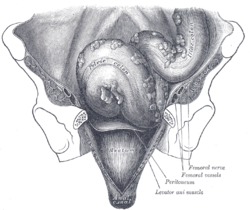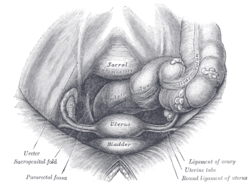Our website is made possible by displaying online advertisements to our visitors.
Please consider supporting us by disabling your ad blocker.
Taenia coli
| Teniae coli | |
|---|---|
 Iliac colon, sigmoid or pelvic colon, and rectum seen from the front, after removal of pubic bones and bladder. (Taenia coli not labeled, but visible at center.) | |
 Female pelvis and its contents, seen from above and in front. (Taenia coli not labeled, but visible at right.) | |
| Details | |
| Identifiers | |
| Latin | taeniae coli |
| TA98 | A05.7.03.013 |
| TA2 | 2993 |
| FMA | 76487 |
| Anatomical terminology | |
The taeniae coli (also teniae coli or tenia coli) are three separate longitudinal ribbons (taeniae meaning ribbon in Latin) of smooth muscle on the outside of the ascending, transverse, descending and sigmoid colons. They are visible and can be seen just below the serosa or fibrosa. There are three teniae coli: mesocolic, free and omental taeniae coli. The teniae coli contract lengthwise to produce the haustra, the bulges in the colon.

The bands converge at the root of the vermiform appendix. At the rectosigmoid junction, the taeniae spread out and unite to form the longitudinal muscle layer. In the caecum, the ascending colon, the descending colon and sigmoid colon the positions of these bands are fixed. The taenia libera, is placed anteriorly in the caecum, ascending, descending and sigmoid colon, but is placed inferiorly in the transverse colon. The taenia mesocolica is present on the posteromedial surface of the caecum, ascending, descending and sigmoid colon, but is placed posteriorly on transverse colon at the site of attachment of transverse mesocolon. The taenia omentalis is situated posterolaterally in caecum, ascending, descending and sigmoid colon, but is situated on the anterosuperior surface of transverse colon where layers three and four of the greater omentum meet the transverse colon. This change in position is due to the twist in transverse colon. These bands correspond to the outer layer of the muscularis externa, in other portions of the digestive tract.
The teniae coli are regulated by the sacral nerves of the spinal cord, which are under control of the parasympathetic nervous system.[1]
- ^ Lambert, H. Wayne; Wineski, Lawrence E. (2011). Anatomy & Embryology. Lippincott Williams & Wilkins. p. 65.
Destruction of the sacral spinal cord will eliminate parasympathetic outflow to the hindgut, pelvic organs, and perineum as well as somatic innervation to much of the pelvis and lower limbs. Because it stimulates gut motility and tone, loss of parasympathetic input will result in relaxation and inactivity of the teniæ coli in the descending colon.
Previous Page Next Page


